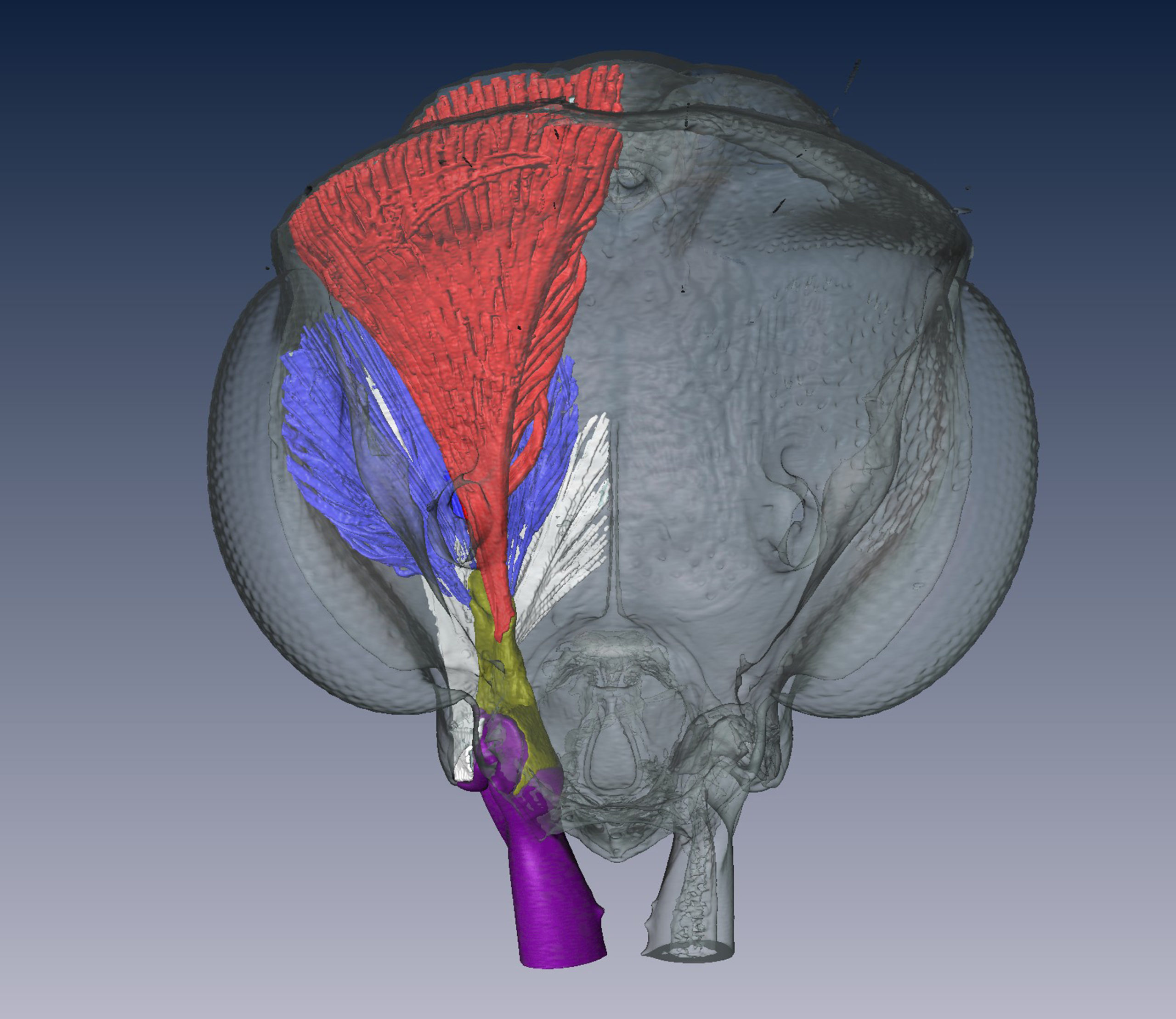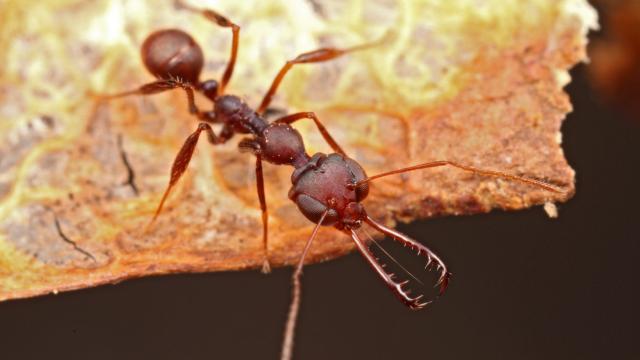Below the tangle of vines and branches of the East Malaysian rainforest, a small contingent of ants scuttles frenetically along the shaded leaf litter. But these are no mere picnic pests — these are Myrmoteras trap-jaw ants, fearsome predators armed with long, spiky, widely-agape mandibles — and they are on the hunt. Suddenly, an insect-like springtail comes into the view of a trap-jaw’s compound eye. With a quick rush from the ant, it’s all over, and the springtail is pitifully pinned in the ant’s prickly jaws.
A close-up image of a Myrmoteras trap-jaw ant. Image: Steve Shattuck.
You’d be forgiven for missing the action, considering that Myrmoteras ants snap their jaws shut ridiculously quickly, too fast for your eyes and brain to register the movement. Now, new research published in the Journal of Experimental Biology has determined how the trap-jaw ants pull off this athletic feat, revealing that the fastest mouth in the jungle is nothing short of a marvel of evolutionary technology.
To solve what was behind this blisteringly fast bite, the research team — made up of scientists from the Smithsonian’s National Museum of Natural History, the University of Arizona, and the University of Illinois — needed to get the ants into the lab where they could a close, detailed look at what was going down on their teeny bug heads. The team collected a couple of colonies of two different species of Myrmoteras trap-jaw ants from the island of Borneo, and raised them in the laboratory. It was clear that the ants’ jaw strike was incredibly fast, but just how fast wasn’t known. So, the trap-jaw ants were restrained and filmed with a high-speed camera. The ants stretched their jaws open a seemingly preposterous 280 degrees, and then, when puffed with a bit of air, snapped their toothy pincers closed with a robotic instantaneousness.
So how fast are these jaws on the draw? Well, when filmed at 1000 frames per second, the ants’ savage snap was still too quick for the movement to be tracked. It took the use of a 50,000 frame per second camera to finally slow the action down enough to see what was going on, showing that the mandibles snap shut in about half a millisecond. This is about seven hundred times faster than you can blink, or about 80km/h at peak velocity. This is right up there among the fastest movements in the animal kingdom, and it’s way faster than what you’d expect for something purely driven by muscle power. It’s possible this extreme speed was the result of “power-amplification”, where movements are made faster or more powerful by the storing and releasing of potential energy, like in a spring or elastic.
To find out if the Myrmoteras ants’ blinding biting speed was granted by a spring mechanism, and what that mechanism was, lead author Frederick Larabee needed to look even closer — and inside. After initially examining the ants with a microscope, Larabee then scanned the heads of the ants using a “micro-CT” imaging system, which uses X-rays to capture three-dimensional images of the internal structures of tiny things. This allowed him to generate a model of how all the internal muscles and exoskeleton came together.

Model of a Myrmoteras trap-jaw ant’s musculature based on micro-CT scanning. Image: Fredrick Larabee, Smithsonian
The micro-CT scans revealed three sets of powerful muscles that appear to be responsible for the trap-jaw ant’s bite. The muscles are huge, together taking up much of the interior of the ant’s head, and include one pair of “opener” muscles and two pairs of “closer” muscles. The jaw-opener muscles start off the process by pulling the mandibles to their extremely wide position. Then, the stronger pair of the “closer” muscles contracts, pulling against a lobe of the exoskeleton at the back of the head, causing it to warp and depress. The warping exoskeletal lobe is likely the spring mechanism, one that becomes loaded with potential energy by the muscle’s effort. It is thought that when prey trips sensitive hairs between the jaws, the weaker “closer” muscle contracts, undoing the latch and allowing everything to release like a bear trap, murderously clasping the hapless meal.
The “trap-jaw” strategy has evolved independently at least four times among ants. Myrmoteras is only distantly related to the other varieties of “trap-jaw ants” that live in the world’s tropics, and the complicated dance of muscles and exoskeleton that seem to drive its jaw strike is unlike anything else in the ant world.
“What’s interesting is that the arrangement of the muscles and how the jaws are locked open are completely different from other trap-jaws ants that have been studied,” Larabee said in a press release. “It seems like it’s a completely unique evolution of this system.”
As fast as Myrmoteras‘s jaws are, they aren’t the fastest among trap-jawed ants. Odontomachus, for example, is a species of ant found all over the tropics that has its own prized set of gnarly jaws. Their bite is more than twice as fast as that of Myrmoteras, and provides enough force that they can use the jaw snap like a catapult, sending them backwards and airborne away from danger. Notably, the jaws of Odontomachus are stouter than those of Myrmoteras, and can handle impacts that might splinter the slender jaws of Myrmoteras.
To be fair, the evolutionary origin of Myrmoteras‘s own speedy bite is likely linked to their favoured food, not defensive tactics. The ants eat springtails, which can explosively jettison themselves into the air to escape a threat. The trap-jaw system is more than quick enough to ensnare and impale a springtail before it can rocket away, and the squishy softness of the springtails’ bodies mean that the thinness of the jaws isn’t a handicap.
Spring-loaded augmentations to muscular actions have evolved many times in the insect world, often in jumping insects like grasshoppers and fleas, and Myrmoteras ants add to that list. It’s certainly possible that more stupefyingly fast, elastic-powered creepy crawlies will show themselves to science in the years to come.
